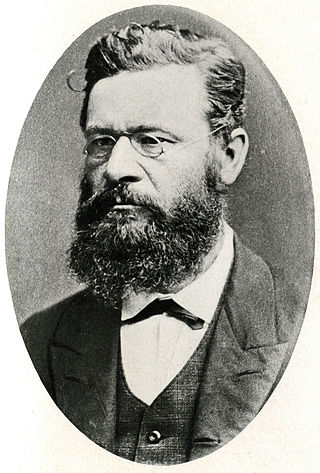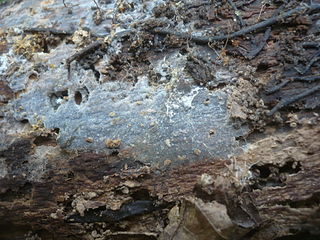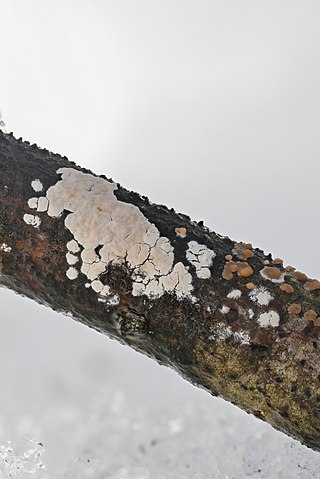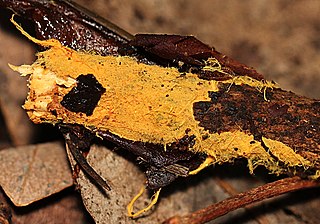Related Research Articles

Petter Adolf Karsten was a Finnish mycologist, the foremost expert on the fungi of Finland in his day, and known in consequence as the "father of Finnish mycology".

Phanerochaete is a genus of crust fungi in the family Phanerochaetaceae.

Hydnellum is a genus of tooth fungi in the family Bankeraceae. Widely distributed in the Northern Hemisphere, the genus contains around 40 species. The fruitbodies of its members grow by slowly enveloping nearby bits of grass and vegetation. There is great variability in the form of Hydnellum fruitbodies, which are greatly influenced by environmental conditions such as rainfall and humidity, drying winds, and temperature. They are too tough and woody to eat comfortably. Several species have become the focus of increasing conservation concern following widespread declines in abundance.

The Phanerochaetaceae are a family of mostly crust fungi in the order Polyporales.

Fomitopsis is a genus of more than 40 species of bracket fungi in the family Fomitopsidaceae.

Phellodon is a genus of tooth fungi in the family Bankeraceae. Species have small- to medium-sized fruitbodies with white spines on the underside from which spores are released. All Phellodon have a short stalk or stipe, and so the genus falls into the group known as stipitate hydnoid fungi. The tough and leathery flesh usually has a pleasant, fragrant odor, and develops a cork-like texture when dry. Neighboring fruitbodies can fuse, sometimes producing large mats of joined caps. Phellodon species produce a white spore print, while the individual spores are roughly spherical to ellipsoid in shape, with spiny surfaces.

Scopuloides is a genus of five species of crust fungi in the family Meruliaceae.

Phlebia is a genus of mostly crust fungi in the family Meruliaceae. The genus has a widespread distribution. Phlebia species cause white rot.

Corticium is a genus of fungi in the family Corticiaceae. Basidiocarps are effused, corticioid, smooth, and grow on dead wood. One species, C. silviae, is lichenicolous. The genus was formerly used in a very wide sense for almost any effused corticioid fungi.

Ceriporia is a widely distributed genus of crust fungi.

Bjerkandera is a genus of wood-rotting fungi in the family Meruliaceae.

Dentocorticium is a genus of six species of poroid fungi in the family Polyporaceae. The genus was revised in 2018, with several new species added and some older species transferred to other genera, based on phylogenetic analyses.

Favolus, or honeycomb fungus, is a genus of fungi in the family Polyporaceae. The fruit bodies of Favolus species are fleshy with radially arranged pores on the underside of the cap that are angular and deeply pitted, somewhat resembling a honeycomb.
Grammothele is a genus of poroid crust fungi in the family Polyporaceae.

Lenzites is a widespread genus of wood-decay fungi in the family Polyporaceae. It was circumscribed by Elias Magnus Fries in 1835. The generic name honours German naturalist Harald Othmar Lenz (1798–1870).

The corticioid fungi are a group of fungi in the Basidiomycota typically having effused, smooth basidiocarps that are formed on the undersides of dead tree trunks or branches. They are sometimes colloquially called crust fungi or patch fungi. Originally such fungi were referred to the genus Corticium and subsequently to the family Corticiaceae, but it is now known that all corticioid species are not necessarily closely related. The fact that they look similar is an example of convergent evolution. Since they are often studied as a group, it is convenient to retain the informal (non-taxonomic) name of "corticioid fungi" and this term is frequently used in research papers and other texts.

Rhizoctonia is a genus of fungi in the order Cantharellales. Species form thin, effused, corticioid basidiocarps, but are most frequently found in their sterile, anamorphic state. Rhizoctonia species are saprotrophic, but some are also facultative plant pathogens, causing commercially important crop diseases. Some are also endomycorrhizal associates of orchids. The genus name was formerly used to accommodate many superficially similar, but unrelated fungi.

Piloderma is a genus of fungi in the family Atheliaceae. The distinguishing characteristics of Piloderma are the thick-walled basidiospores, the club-shaped basidia with stalk-like bases, and the clampless-septate hyphae. The widespread genus contains six species.

Xenasmatella is a genus of corticioid fungi in the order Polyporales. Circumscribed by German mycologist Franz Oberwinkler in 1966, the widespread genus contains 27 species.

The Irpicaceae are a family of mostly polypores and crust fungi in the order Polyporales.
References
- ↑ Ghobad-Nejhad, Masoomeh; Kotiranta, Heikki (2007). "Re-evaluation of Radulomyces rickii, with notes on Phlebiella and Radulomyces (Corticiaceae, Basidiomycota)". Mycotaxon. 102: 101–111.
- ↑ Karsten, P.A. (1890). "Fragmenta mycologica XXXI". Hedwigia (in Latin). 29: 270–273.
- ↑ Donk M.A. (1963). "The generic names proposed for Hymenomycetes – XIII". Taxon. 12 (4): 153–168 (see p. 163). doi:10.2307/1216184. JSTOR 1216184.
- ↑ "Xenasmatella Oberwinkler 1966". MycoBank. International Mycological Association. Retrieved 2016-11-16.
- ↑ "Record Details: Phlebiella vaga (Fr.) P. Karst". Index Fungorum. CAB International. Retrieved 2016-11-16.
- ↑ "Species Fungorum - Search Page". www.speciesfungorum.org. Retrieved 2024-01-19.
- ↑ Maekawa, N. (1993). "Taxonomic study of Japanese Corticiaceae (Aphyllophorales). I. Reports of the Tottori Mycological Institute". 31: 1–149 (see p. 124).
{{cite journal}}: Cite journal requires|journal=(help)